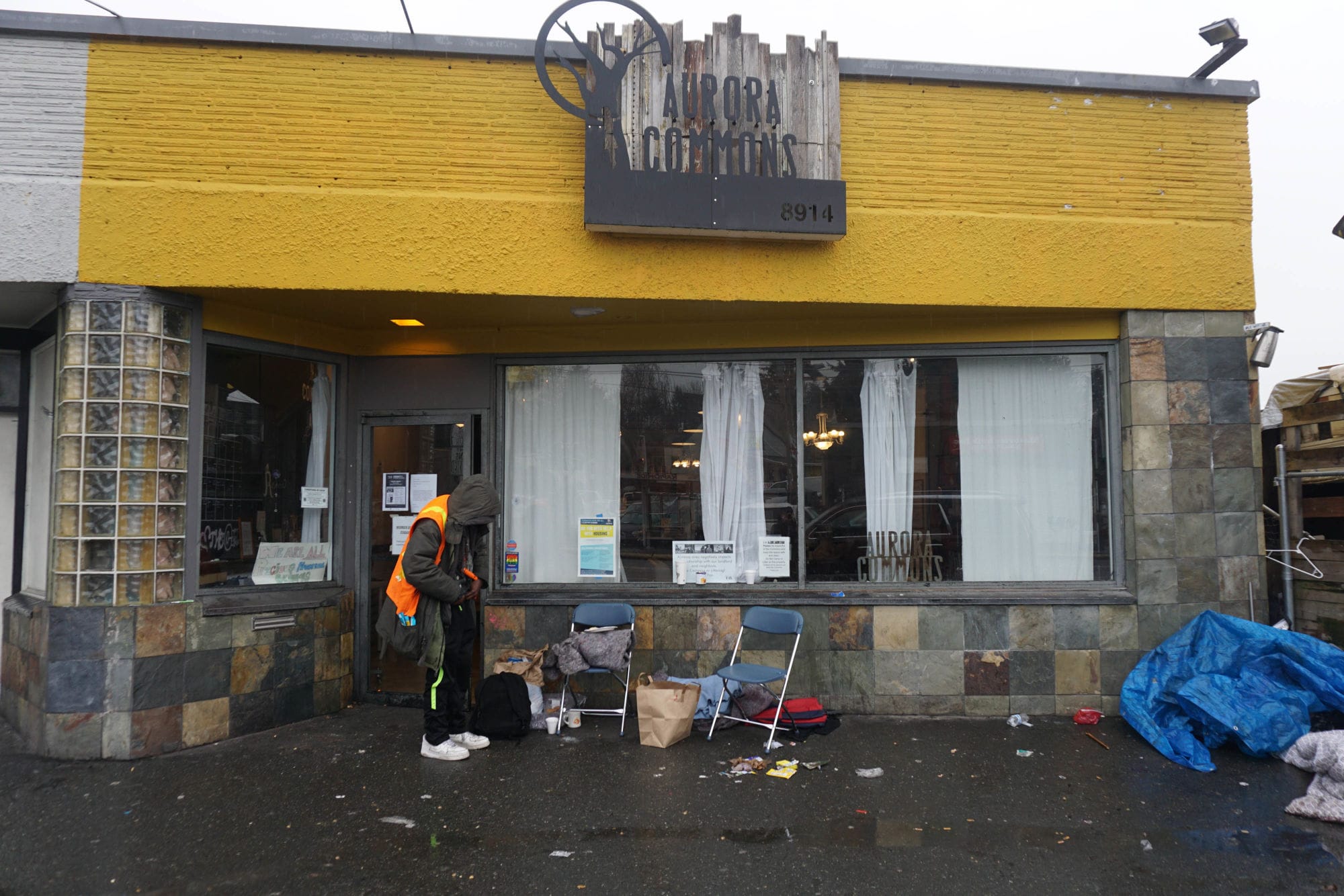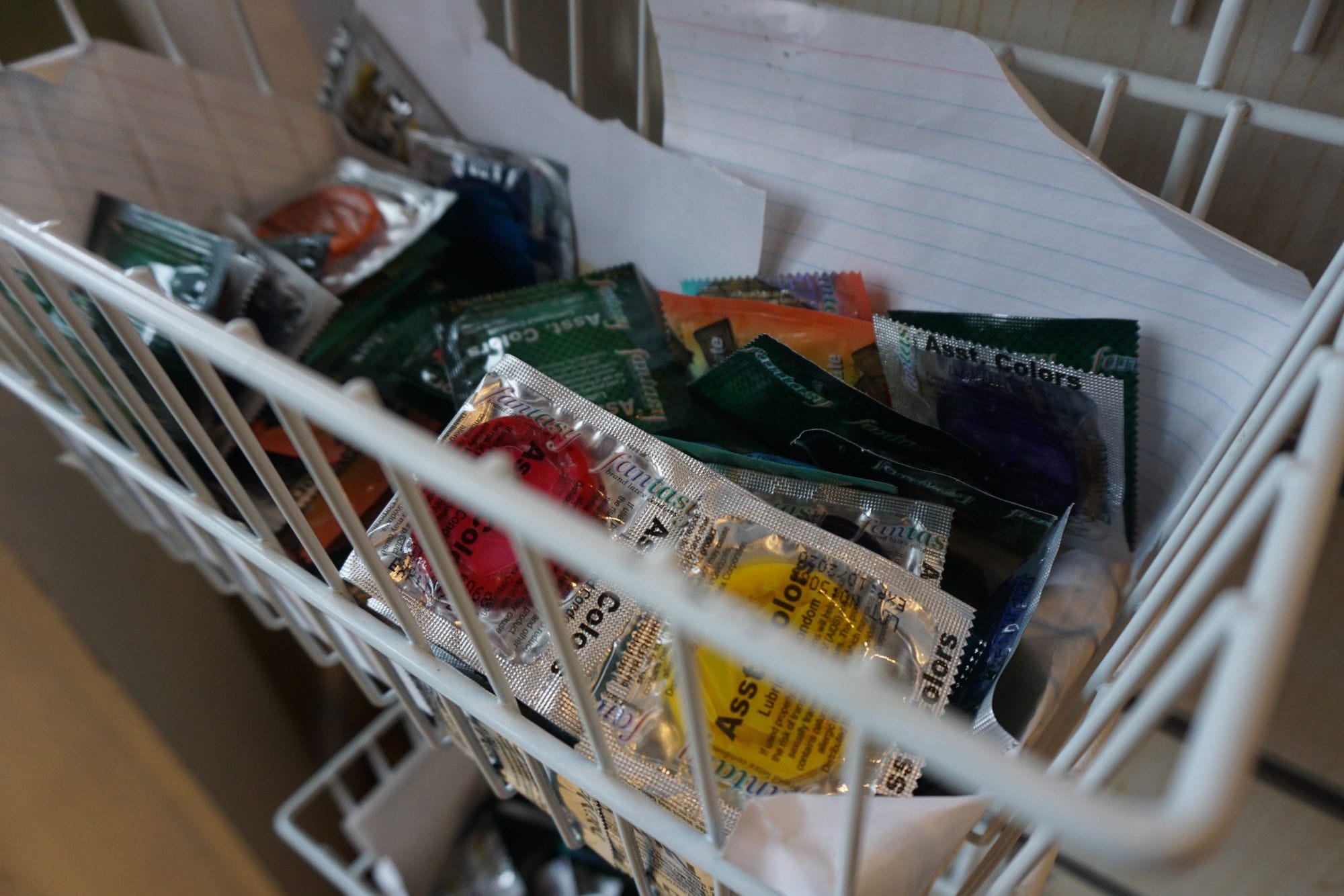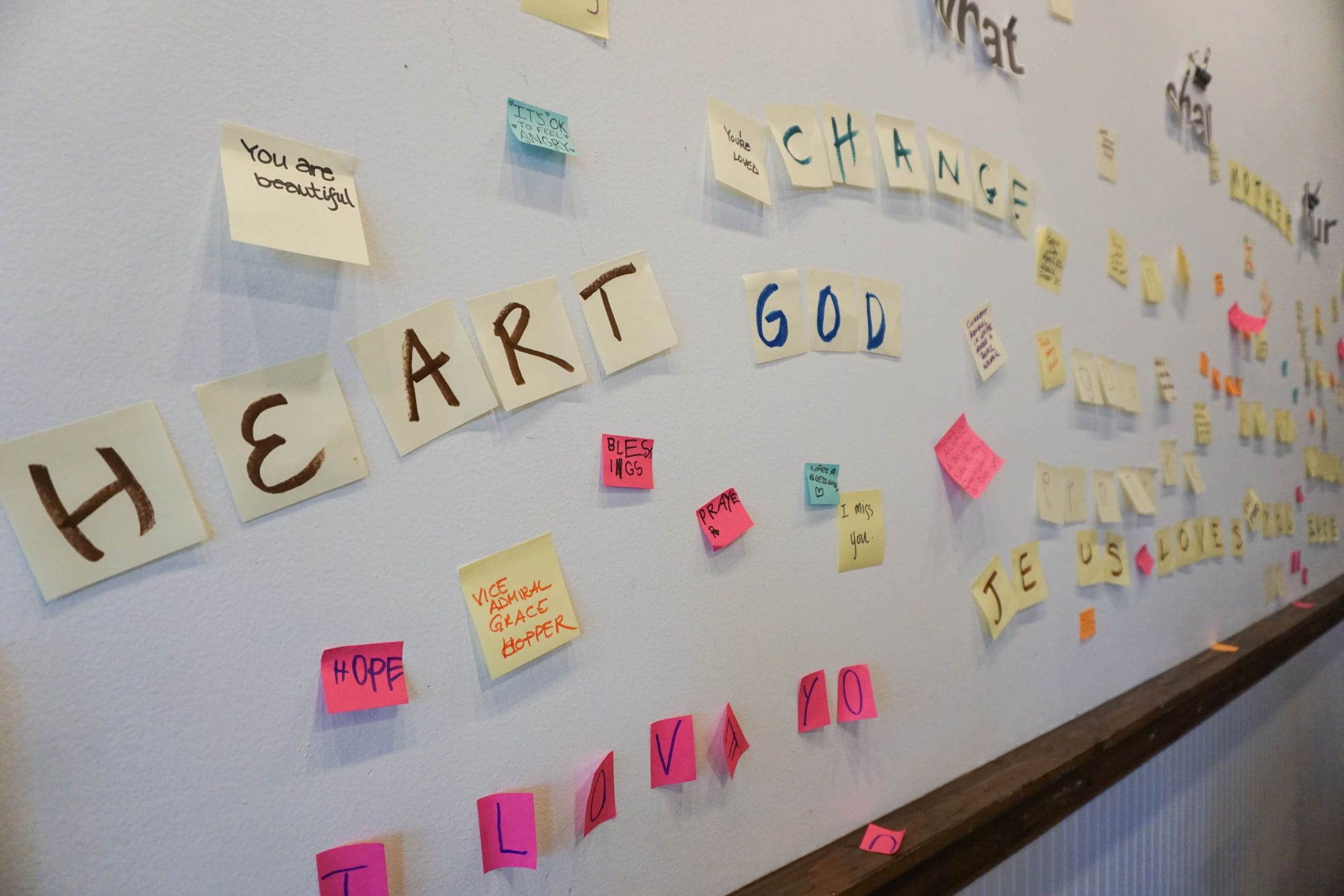“White male: roughly 70 years old, goes by name Thomas-driving a red 4 door suv picked up woman in Lynnwood but frequents aurora avenue as well. Was calm at first but eventually got angry, was slamming on the breaks and when woman yelled for him to stop- he parked and tried to strangle her and punched her, then raped her.”
This recently updated “Bad Date List” posting and handfuls of condoms in assorted colors greet dozens of women and men as they step into the Aurora Commons, a day shelter near the intersection of Aurora Avenue and North 90th Street.
The building’s lemon-yellow façade stands in defiant contradiction to the slate-gray skies, highlighting a small oasis in the heart of Seattle’s forgotten desert. Once inside, visitors, most from the neighborhood, step into a space intended to be a “community living room” where anybody can enjoy a bit of beauty and comfort.
High, drunk, gay, trans, sex-worker, drug-dependent, unhoused, all of the above, none of the above, it doesn’t matter; everyone is welcome at the Aurora Commons.
It is also one of the only low-barrier day shelters in all of Seattle. “Low barrier” is a broadly used, rather vague term describing social service agencies that have few or no restrictions on who is welcome. Some experts say that low-barrier places like these are a critical tool in fighting the region’s opiate crisis, providing safety and connections to potential help for people who would otherwise be turned away.

The Aurora Commons is small, but homey. Cinnamon-colored walls and home cooked meals radiate warmth and comfort to visitors. A floor-to-ceiling bookshelf offers reading on topics ranging from biography to spirituality and fiction. A sign asks, “Want some light reading for the bus? Take a magazine from us.” A lot of the visitors — neighbors, as the Commons considers them — take up the offer.
A large dining room table, surrounded by a dozen or so chairs, is frequently covered with steaming coffee, biscuits and gravy, chicken, bacon and soup. In the back of the room is a kitchen with an island, where neighbors are encouraged to cook their own meals. Bread is broken as a soundtrack of laughter and tears and fear and joy streams throughout the space. People come here to find resources, they come here to sit in peace.
On a bone-chilling February evening, Tanisha Wright is sitting at the sturdy wooden table. She is a mother of three, unhoused and just getting out of a long-term relationship marked by domestic violence. She’s carrying her daughter Maya, who is 2-and-a-half years old. Tonight, Wright is planning to sleep on the street.
“Do you know what they’re saying about the weather tonight?” she asked. “They’re saying it’s gonna be 20 degrees.”
Despite the circumstances, she says, she’s just trying to stay in good spirits and keep her head clear.
“I just need a little help, just a place, a room, anything over my head. It’s hard,” Wright said, adding that, “I’m not helpless, I’m just homeless. I can work.”
On this evening, Lisa Etter Carlson, the director of Health & Women’s Initiatives and co-founder of the Aurora Commons, is helping Wright search for a safe place to sleep. Etter Carlson has been involved in community work in Seattle for the last 10 years, and she’s lived a little longer than that in the Aurora neighborhood, where there is an inverse relationship between the street numbers and wealth along these 20 blocks. The further north you go, the more the streets harden. She currently lives across the street from the shelter, saying with a “good arm,” you could throw a ball from her house to the Commons.
During that time, Etter Carlson, who has a masters of theology and culture and certification as a sexual assault victim’s advocate, has gotten to know her unhoused neighbors. She had previously helped to found the Green Bean, a nonprofit coffeehouse in north Seattle with a similar philosophy to the Commons. Following an arson at the coffeehouse that left it without a permanent location for a time, Etter Carlson and her neighbors began hosting backyard community barbecues, sometimes reaching up to 100 people. As one fall approached, though, and weather rained on their parade, Etter Carlson began “dreaming and scheming” to start a nonprofit that could run year-round.
One day, an old coffee shop on Aurora Avenue, which Etter Carlson and her husband happened to live right behind, went up for sale. They grabbed it, gutted it and remodeled it. Thus, the Aurora Commons was born.
Etter Carlson said she knew the place needed three things: First and foremost, it had to be beautiful, because unhoused, drug-dependent folks and people involved in sex work weren’t allowed in any other beautiful spaces.
Second, she wanted it to be like a community living room based around a kitchen. There were no places she knew of where unhoused folks could make their own food, something she says allows a feeling of autonomy and empowerment. Unhoused folks often receive food stamps, but then have nowhere to cook.
Back in January, three people died in a string of heroin overdoses along Aurora within a series of hours. Two of the deceased were regulars at the Commons.
As for the third, arguably most important, requirement, Etter Carlson knew the Aurora Commons wouldn’t have rules. Basically, anyone can come in as long as they aren’t acting dangerously.
“I mean literally, they are not welcomed anywhere [else] on Aurora,” Etter Carlson said.
The Commons is staffed with people from various backgrounds in nonprofit work, psychology and theology. Many of them specialize in working with abuse and trauma victims.
It is unlike any other day shelter in north Seattle that she knows of, often described as providing radical hospitality to the neighbors. Etter Carlson said this sentiment saddens her. “I wish it wasn’t radical. I look forward to the day where it’s not considered to be that.”
While not a social-service agency, the Commons offers a number of programs, such as women-only times where only those who identify as women are allowed in. Many of the lives of women on Aurora are dictated by the needs of men, so the women-only times allow a break from that dynamic. Other programs include a foot and wound care clinic, since many who frequent the Commons walk for miles and miles every day.
Etter Carlson knows approximately 150 women involved in street-based sex work on Aurora. They range in ages, colors and backgrounds, and she says she’s seen an increasing number of women, particularly trans-women, in sex work over the years.
The Aurora Commons is a part of the “Bad Date List,” which allows women to report if they were raped, beaten or cheated out of money by a John. Other women who work on the streets can then see those reports and know who to look out for, who to avoid.
“We’re very aware that there are so many people isolated in the motels, both being trafficked and pimped, and are just unable to leave because of mental illness, etcetera, that we don’t even have access to,” Etter Carlson said.

Tightly connected to the street-based sex work on Aurora is substance use. Chances are, if a woman is engaged in sex work, she’s also using.
Whether or not involved in sex work, about 90 percent of the people who visit the Commons use some substance, she says.
The Commons embodies a “harm reduction approach,” meaning that it encourages and creates safe access. While the staff are more than willing to point people in the direction of social service agencies, they never impose “help” or treatment on anyone who isn’t seeking it.
Due to the community-based approach at the Commons, Etter Carlson and her staff have built very close relationships with the people who come in — friendships that come with an emotional cost.
“That means that you also have to feel a lot, because every day we hear about people getting raped,” Etter Carlson said. “We have friends die from overdose.”
Back in January, three people died in a string of heroin overdoses along Aurora within a series of hours. Two of the deceased were regulars at the Commons.
She said that after these overdose deaths, she requested and received Narcan, the brand name for overdose-reversal drug naloxone, from both the King County Public Health.
“I just need a little help, just a place, a room, anything over my head. It’s hard,” Wright said, adding that, “I’m not helpless, I’m just homeless. I can work.”
“We’ve been handing them out like candy,” Etter Carlson said. “We’re trying to keep our people safe.”
Seattle Police Department’s Sgt. Sean Whitcomb refers to naloxone a “miracle drug,” and many police officers, particularly bike officers, have been equipped with it. “But it's not the only answer to a very complex problem,” he said.
In the last month and a half following that string of overdoses, Etter Carlson hasn’t seen one fatal overdose in the neighborhood. Perhaps, she says, this can be attributed to the surge in distribution of Narcan.
Brad Finegood, co-chair of a county Task Force on Heroin and Prescription Opiate Addiction, said given the climate along Aurora, “The need for low-barrier harm-reduction places are extremely significant in this community.”
Finegood said many people who have substance use disorder have had “adverse childhood experiences,” such as sexual, emotional and physical abuse. He said low-barrier facilities in which people can be treated with respect are critical to their well-being.
In his role on the task force, Finegood worked to outline the logistics for proposed safe-consumption sites, which are something Etter Carlson supports, for safety reasons. She and neighbors see the results of open drug use around them in the form of discarded needles. Because there are currently no designated safe places for IV drug use, users do so behind dumpsters, in alleys, and quickly, too, because they can’t get caught.
“Which means that they’re probably not injecting in a safe way,” Etter Carlson said. “Which means that they’re getting Hepatitis C.” And they are more likely to be using alone, increasing the risk of a fatal overdose since no one is nearby to summon help or administer naloxone.
Etter Carlson said while drug use in the neighborhood is rampant, none of the people she knows who use drugs do so to get high – they all use drugs to “get well.”

“They wake up in the morning and they’re sick,” she said. “So, they have to get drugs to feel OK. And so they spend their whole existence trying to make enough money just to get well.”
At the Commons, it’s getting toward the 9 p.m. closing time on this frozen February evening, and Tanisha Wright, the mother of three, is getting desperate. She dreads the night ahead. She dreads the biting cold. She dreads bringing her daughter out of the Commons, reiterating that there’s no reason anyone should be outside after 9.
She has been trying to get in touch with a family shelter on Aurora all day, but each call has gone unanswered. Finally, she gets through.
The shelter has a spot for her and Maya.
Wright has tears in her eyes. Overcome with joy, she has to pass the phone off to Etter Carlson to talk to the shelter employee.
“I get to stay in a shelter tonight! Oh, my God, I’m so happy.”
For Etter Carlson, the good news is a relief, too. “One of the hardest moments of my day and my week,” Etter Carlson said later, “is saying goodbye to my friends out in the pouring down rain and cold and having them just invite me so kindly to go home and rest.”
“And they often look at me and tell me that I need to go,” she said. “I need to go home and I need to take care of my family, and then they’ll walk me home and they’ll give me a big hug.”
While Tanisha Wright absorbs the good news, Maya wraps her little arms tightly around her mother. “One hour at a time, honey,” Tanisha Wright says.
As the two get ready to leave the comfort and companionship at Aurora Commons, they know that, at least for tonight, there is also somewhere warm, safe and dry to sleep.


